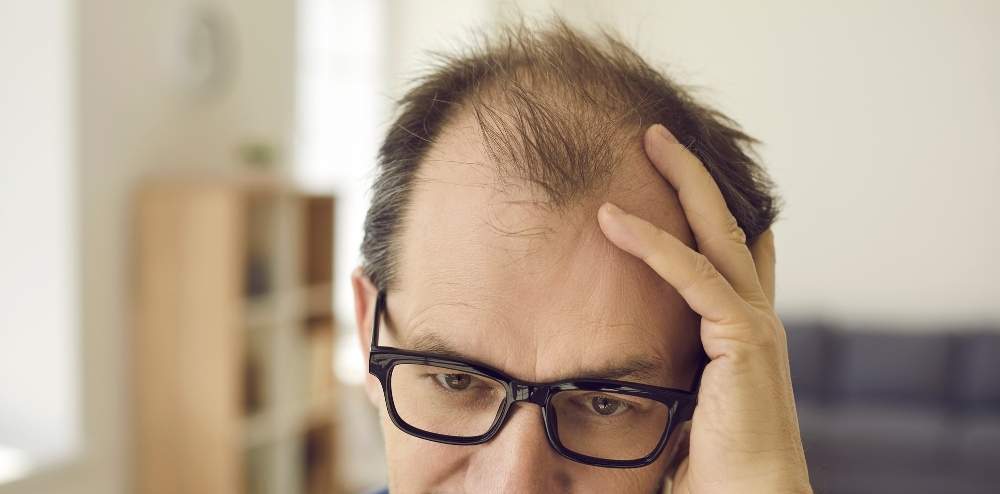Both genetic and hormonal factors contribute to male pattern baldness, which affects men of all ages. Typically, it begins with hair loss at the temples and the top of the head, progressing to a receding hairline and bald spots. You can take preventative or corrective action against hair loss by learning the warning indications of male pattern baldness.
Male Pattern Baldness: A Look at the Genes
Male pattern baldness runs in families and is passed on from father to son. Male pattern baldness is almost always caused by mutations in the androgen receptor gene, which is located on the X chromosome. This gene is typically passed down from the maternal side of the family to male offspring, although it can also be inherited from the paternal side.
When Does Male Pattern Hair Loss First Appear?
Although it can begin at any time, males over the age of 50 have the highest incidence of male pattern baldness. In some people, it begins in their late teens or early 20s. The majority of men, nevertheless, see the onset of male pattern baldness between the ages of 30 and 40.
The First Warning Signs
Possible signs to male-pattern baldness are:
Hair thinning at the crown and temples
Hairline thinning or loss
Fuller coverage of the area
Hair loss becomes more noticeable
Hair thinning in a horseshoe pattern on the crown and scalp.
Male Pattern Baldness Stages
Male pattern baldness can go through many stages, each representing a different degree of hair loss. Among these steps are:
Stage 1: minimal hair loss, with a barely visible receding hairline
Stage 2: mild hair loss, with a receding hairline becoming more noticeable
Stage 3: moderate hair loss, with a significant recession of the hairline and thinning hair on the crown
Stage 4: severe hair loss, with a large bald spot on the crown and hairline continuing to recede
Stage 5: extensive hair loss, with the bald spot on the crown merging with the receding hairline
Stage 6: complete baldness on the crown with some hair remaining on the sides and back of the head
Causes and Risk Factors for Male Pattern Baldness
The development and progression of male pattern baldness can be affected by a number of variables.
Hormonal Variations: The derivative of testosterone known as dihydrotestosterone (DHT) is the culprit in male pattern baldness. Male pattern baldness is caused by a combination of declining testosterone and rising amounts of the androgen dihydrotestosterone (DHT).
Genetics: As was previously noted, male pattern baldness can be passed down through generations in families.
Age: Because the aging process often results in hair follicles shrinking and finally stopping production of hair, male pattern baldness is more common in older men.
Lifestyle: Stress, smoking, and poor dietary habits are just a few examples of how our daily lives can play a role in causing or accelerating hair loss.
How Late in Life Can Male Pattern Baldness Begin?
Although male pattern baldness typically begins in a man’s twenties or thirties, it can also begin in a man’s forties or fifties. Loss of hair is a typical problem for males in their 40s, 50s, and beyond. In fact, some men experience a delay in hair loss until they are in their 70s or later.
Genetics, hormonal shifts, and environmental variables have all been linked to the development of male pattern baldness. It’s important to remember that male pattern baldness can begin at any age, even in middle age or beyond. Consequently, the rate of hair loss progression is less likely to be rapid in the 50s and 60s than it would have been in the 20s and 30s.
Is It Possible to Stop Male Pattern Baldness?
There is currently no treatment or prevention method for male pattern baldness. Fortunately, there are things you can do to lessen the visual effects of hair loss and make yourself seem better while dealing with it. Promoting healthy hair development and preventing or delaying further hair loss can be accomplished through measures such as eating right, not smoking, not drinking excessively, and controlling stress.
Treatments for hair loss can be helpful in delaying the onset of male-pattern baldness. Finasteride, minoxidil, and hair transplant surgery are all options. Consult a professional hair loss specialist if you’re worried about hair loss and want to learn more about your treatment and prevention options.
Conclusion
While millions of men throughout the world deal with male pattern baldness, it’s vital to know that there are options beyond accepting the disease. Effective therapies exist to both halt further hair loss and restore a larger, younger-looking mane of hair.
We at Antalya Hair Transplant are sensitive to the toll that hair loss may take on a person’s sense of well-being and confidence. Because of this, we provide cutting-edge hair transplant and restoration therapies, such as beard transplant and laser therapy, to help our clients realize their aesthetic goals and boost their self-esteem.
Please don’t wait to get in touch with us if you have any questions regarding our hair transplant services or would want to set up a consultation. If you’re suffering from hair loss, our team of experts is here to help you find a solution that works for you.







